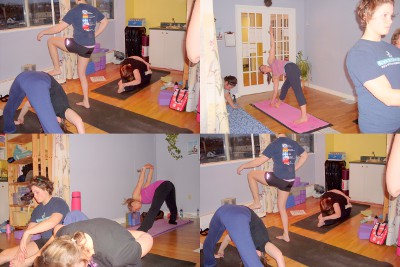When I talk to people about coming to a Mysore class, I get lots of reactions, most of them are negative.
- I do not know the sequence of postures well enough.
- My own practice is not good enough.
- I am not flexible enough.
- I can not do all of the postures.
- I will look stupid.
The list goes on and on but the above is the bulk of the responses that I get.
I thought that I would try and address these concerns in a series of articles. I am going to approach this in four parts.
- Part I – What is a Mysore Class
- Part II – What are the benefits of a Mysore class
- Part III – What is the Etiquette in a Mysore class
- Part IV – Yes but . . .
Part I – What is a Mysore class
Chaos
The first thing to strike you when you walk into a Mysore style Ashtanga yoga class is that it seems like total chaos. There’s one person doing a headstand in the corner, while another is coming into the triangle posture and a third is struggling to balance on her arms. What is going on here? If you stay a while and watch closely, you start to notice a pattern emerging. Everyone seems to be on a path, following a precise choreography.
Silence
Compared to other yoga classes, the silence is striking. Occasionally the teacher will whisper something to a student, but the dominant sound is the collective breath. You’ll notice the teacher moving swiftly from student to student, giving adjustments as appropriate. Pretty much all you are going to hear is the collective sound of many people breathing.
Personal practice in a group setting
The class is not “led” as a whole but rather all instruction is one-on-one within the group class setting. You practice your own portion of the Ashtanga sequence of asanas at your own pace. You follow your breath and move forward at your own pace. The teacher will assist you individually by giving you physical adjustments & verbal instruction as required.
The person next to you may be doing easier poses, harder poses, going at a faster pace or a slower pace. It does not matter to you. You are doing your practice and they are doing theirs.
Where did the name come from
This style of practice is named after the city of Mysore which is in the south of India. This is where Sri K. Pattabhi Jois taught Ashtanga yoga since the 1930’s using this style of individual practice within a group setting.
Mysore style Ashtanga Yoga is the only yoga class that truly works for students of all levels.
Next time
Next time we will talk about the benefits of a Mysore class.





this was fantastic- found you through twitter (Helen tweeted about your blog post 🙂 ).
I’ve always wondered what a Mysore class looks like. It actually sounds so much more welcoming and all encompassing than usual ashtanga-led classes (which can be great as well!). It’s interesting, because I also assumed that Mysore would be harder… and scarier.
Thank you for the clear, concise info! I look forward to the next installment.
Blessings!
Lisa
Thanks Lisa
The other installments of the series are available now.
Mysore style is only scary because it is new. Once you try it you really like it. This style of teaching is same as the way yoga was originally taught from teacher to student one on one.
Jack